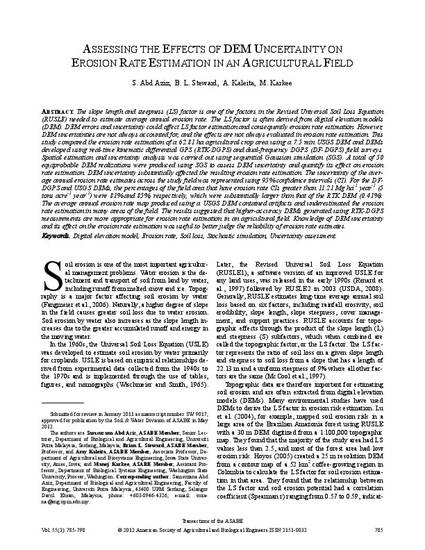
The slope length and steepness (LS) factor is one of the factors in the Revised Universal Soil Loss Equation (RUSLE) needed to estimate average annual erosion rate. The LS factor is often derived from digital elevation models (DEM). DEM errors and uncertainty could affect LS factor estimation and consequently erosion rate estimation. However, DEM uncertainties are not always accounted for, and the effects are not always evaluated in erosion rate estimation. This study compared the erosion rate estimation of a 62.81 ha agricultural crop area using a 7.5 min USGS DEM and DEMs developed using real-time kinematic differential GPS (RTK-DGPS) and dual-frequency DGPS (DF-DGPS) field surveys. Spatial estimation and uncertainty analysis was carried out using sequential Gaussian simulation (SGS). A total of 50 equiprobable DEM realizations were produced using SGS to assess DEM uncertainty and quantify its effect on erosion rate estimation. DEM uncertainty substantially affected the resulting erosion rate estimation. The uncertainty of the average annual erosion rate estimates across the study field was represented using 95% confidence intervals (CI). For the DF-DGPS and USGS DEMs, the percentages of the field area that have erosion rate CIs greater than 11.21 Mg ha-1 year-1 (5 tons acre-1 year-1) were 81% and 85%, respectively, which were substantially larger than that of the RTK DEM (0.41%). The average annual erosion rate map produced using a USGS DEM contained artifacts and underestimated the erosion rate estimation in many areas of the field. The results suggested that higher-accuracy DEMs generated using RTK-DGPS measurements are more appropriate for erosion rate estimation in an agricultural field. Knowledge of DEM uncertainty and its effect on the erosion rate estimation was useful to better judge the reliability of erosion rate estimates.
Available at: http://works.bepress.com/brian_steward/44/

This article is from Transactions of the ASABE, 55, no. 3 (2012): 785–798.